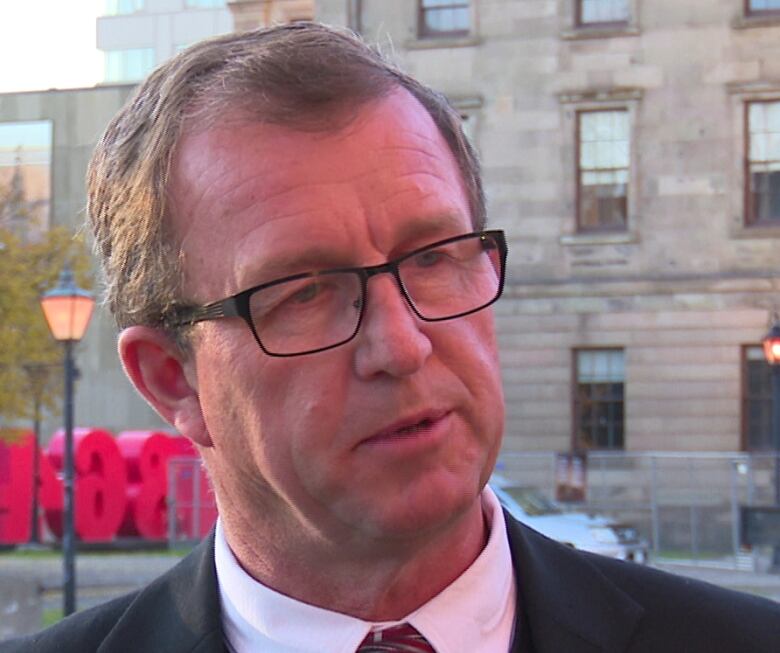Voting options: Dual member proportional
System never used before, developed for use in Canada

Between Oct. 29 and Nov. 7, Islanders will be asked to weigh in on electoral reform in a provincial plebiscite. This week, CBC explains each of the five systems presented on the ballot.
Anna Keenan moved to P.E.I. just in time for the 2015 provincial election.
She said nothing in her travels around the world to that point prepared her to witness a first-past-the-post election.
"I had never witnessed anyone needing to vote strategically in the countries that I've lived and worked in: Australia, the Netherlands, Germany, Japan," she said.
"And then, when I really looked into the history of voting on P.E.I. I was shocked to see these extreme majorities and extreme minority oppositions. The 2000 election was shocking for me to see the numbers, 26 MLAs from one party and just one from the opposition? That's crazy."

And so Keenan found herself in front of P.E.I.'s Special Committee on Democratic Renewal six months after the election, telling the committee it should consider a brand-new electoral model for P.E.I.: something called dual member proportional.
- Voting options: First past the post
- Voting options: First past the post plus leaders
- Voting options: Mixed member proportional
How DMP works
The dual member proportional model was developed by Sean Graham, a political science student at the University of Alberta.
His web page explains how he tried to develop an electoral model that would work in Canada: it has a simple ballot design, does away with party lists used by other PR models, and assigns every MLA to a geographic district, unlike other PR models which include some representatives elected at large.
Under DMP, P.E.I. would be split into 14 electoral districts, each to be represented by two MLAs, increasing the size of the legislature from 27to 28.
Parties would put forward either one or a team of two candidates in each district.
Electors would mark just one "X" on their ballot, as they do now, for their preferred party'scandidate to represent their district. Where parties run two candidates, electors would vote for them both together.
In each of the 14 districts, the candidate with the most votes is elected to represent the district in a first-past-the-post election, just as they are under the current system. In districts where parties run two candidates, the first candidate listed is awarded the seat. Parties decide the order of their own candidates.
Districts get a second MLA
Once those 14 seats are awarded under first past the post, the overall popular vote is calculated. That will be used to determine the overall proportion of seats in the House.
The 14 remaining seats are awarded to the parties, one per district, in order to achieve a balance of seats in the legislature that matches the popular vote.

These 14 seats are awarded to the candidates who received the largest shares of the overall popular vote for each party (without winning a district through the first-past-the-post elections).
Elections P.E.I. says in most cases, districts will end up represented by the top two vote winnersin their riding. It also says districts would normally have MLAs from two different parties under this system. Thus it's unlikely (but still possible witha big enough win) that any party's second candidate in a district would actually get elected.
What it could mean for the P.E.I. legislature
CBC did an analysis of the 2015 provincial election results and how those mightlook under the different voting systems being put forward in the plebiscite.
Under DMP the 2015 provincial election would have led to a House made up of:
-
11 Liberal MLAs (40.8per cent of the vote).
-
11 PC MLAs (37.4 per cent).
-
3 NDP MLAs (11.0 per cent).
-
3 Green MLAs (10.8per cent).
These are projections only, as different electoral systems could change the way people vote.
This leaves one more PC MLA than under a mixed member proportional system and the same number of PCMLAs and Liberal MLAs.
Initially CBC's analysis left the last seat as an unknown. At the time CBC conferred with P.E.I.'s standing committee on democratic renewal which agreedit wasn't clear how the last seat would be awarded based on rounding the numbers.
Elections P.E.I. has now confirmed the DMP system underconsiderationin the plebiscite awards the final seat to the party with the highest remainder of the seatpercentage which in the case of the 2015 election was the PCs.
'The voters have a voice'
Keenan says under proportional representation, voices would be added to the legislature which already have the support of voters but which have been excluded under first past the post.
"I think the legislature should reflect what the overall population thinks. That's what democracy is, it's meant to be, the voters have a voice, and then they get fair representation of their ideas."
But proportional representation has its share of detractors on the Island. DMP addresses some concerns raised on P.E.I. in the past by getting rid of party lists and making sure each MLA is tied to a specific district, but it would still increase the likelihood of minority or coalition governments.

"I like the fact that we have majority governments, I think you get a lot better results," said P.E.I. Minister of Agriculture and Fisheries Alan McIsaac.
McIsaac is advocating another new electoral model first past the post plus leaders a tweak to the status quo that would give party leaders a seat if their parties obtained 10 per cent of the popular vote.
He says that would add new voices to the legislature without being too big a change for the Island to absorb.
"Sometimes change is slow to grab hold here on P.E.I., maybe we need to move a little bit at a time. But we'll let the people decide."
- MORE P.E.I. NEWS | 'It has to take its time': How to make award-winning P.E.I. wines
- MORE P.E.I. NEWS | Aging with dogs: P.E.I. group that helps seniors care for canine companions growing












_(720p).jpg)


 OFFICIAL HD MUSIC VIDEO.jpg)
.jpg)



























































































